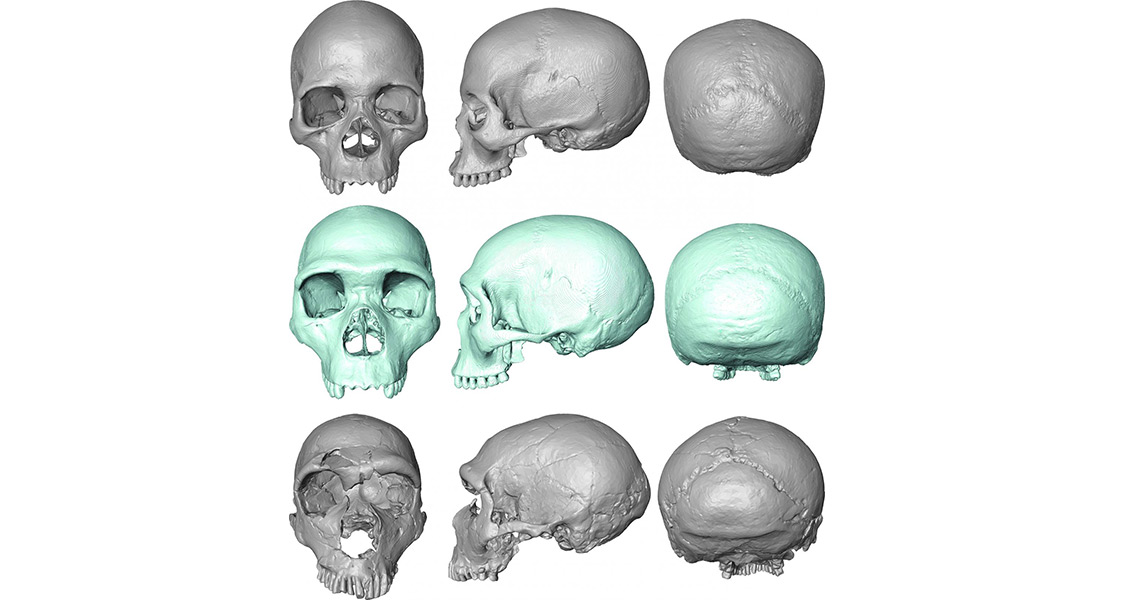<![CDATA[A 3D model of the skull of the last common ancestor to both humans and Neanderthals has been created by a team of scientists from Cambridge University. The results of the project, published last week in the Journal of Human Evolution, suggest that the populations which led to the lineage split were actually much older than previously thought. It is widely accepted that humans and Neanderthals - our closest extinct prehistoric relative - share a common ancestor. Exactly what this ancestral population looked like remains shrouded in mystery however, due to a paucity of fossils from the Middle Pleistocene period when the split is likely to have occurred. Led by Dr. Aurélien Mounier from Cambridge University’s Leverhulme Centre for Human Evolutionary Studies (LCHES), the researchers decided to apply an innovative solution to the limitations of the fossil record. Digital 'morphometrics' and statistical algorithms were applied to cranial fossils from the histories of both Neanderthals and humans. "This allowed us to predict mathematically and then recreate virtually skull fossils of the last common ancestor of modern humans and Neanderthals, using a simple and consensual ‘tree of life’ for the genus Homo." said Mounier in a press release from Cambridge University. Almost two million years of Homo history were used to extract data for the 'virtual fossil'. 797 landmarks on the crania of fossil skulls such as a 1.6 million year old Homo erectus fossil, Neanderthal crania from across Europe, and even nineteenth century skulls from the Duckworth collection in Cambridge, were plotted to create an evolutionary framework for skull development Using the data collected, the team were able to predict a timeline of the morphology of our ancient ancestors. A digital scan of a modern skull was then fed into the timeline, with the researchers warping its shape to match the landmarks as they progressed back through history. "Our models are not the exact truth, but in the absence of fossils these new methods can be used to test hypotheses for any palaeontological question, whether it is horses or dinosaurs." said Mounier in the press release. After generating three possible ancestral skull shapes which corresponded to three predicted split times between the two lineages, the team compared digitally rendered complete skulls with the few available fossils from the Pleistocene. This allowed them to determine the most likely point for the split. The team's results throw into question other studies' conclusions on the development of humans and Neanderthals. Previous estimates based on DNA analysis suggested that the last common ancestor lived around 400,000 years ago. However, Mounier et al's 3D model suggests the lineal split occurred around 700,000 years ago. It also suggests the most recent common ancestor originated in Africa, despite being present throughout Eurasia. Mounier said that overall the 3D fossil model was more reminiscent of Neanderthals than humans, unsurprising when one considers that Homo sapiens are the biggest divergence from the ancestral lineage. The virtual ancestor featured a heavy, thickly set brow, an idiosyncrasy common in Neanderthals and other ancestors, but lost in modern humans. Study co-author Dr. Marta Mirazón Lahr suggests that differences between modern humans and other parts of the ancestral tree can be explained through historical circumstances. "The possibility of a higher rate of morphological change in the modern human lineage suggested by our results would be consistent with periods of major demographic change and genetic drift, which is part of the history of a species that went from being a small population in Africa to more than seven billion people today," Mounier and his team are currently working on their project, creating a similar model to pinpoint the last common ancestor of human's and chimpanzees. Image courtesy of Dr. Aurélien Mounier]]>
Last Common Ancestor of Us and Neanderthals Revealed
